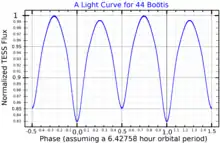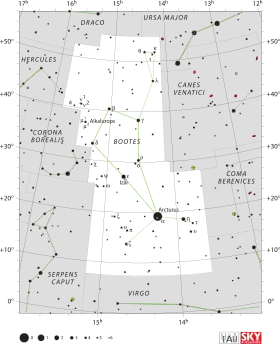44 Bootis
44 Bootis ou i Bootis est une étoile triple de la constellation du Bouvier. Elle est à environ 41,6 années-lumière de la Terre.

| Ascension droite | 15h 03m 47,29565s[2] |
|---|---|
| Déclinaison | +47° 39′ 14,6228″[2] |
| Constellation | Bouvier |
| Magnitude apparente | 4,75[3] (5,136 / 6,004)[4] |
Localisation dans la constellation : Bouvier  | |
| Type spectral | G0Vnv[5] + (K0V + K4V)[6] |
|---|---|
| Indice U-B | 0,09[3] |
| Indice B-V | 0,65[3] |
| Variabilité | W UMa |
| Vitesse radiale | −17,89 km/s[7] |
|---|---|
| Mouvement propre |
μα = −445,84 mas/a[2] μδ = 19,86 mas/a[2] |
| Parallaxe | 78,39 ± 1,03 mas[8] |
| Magnitude absolue | +2,211[8] / +5,38[9] |
| Masse | 1,04 ± 0,10 M☉[10] |
|---|---|
| Gravité de surface (log g) | 4,33[11] |
| Luminosité | 1,552 L☉[4] |
| Température | 5 877 K[11] |
| Métallicité | −0,24[11] |
| Âge | 1,4–1,5 G a[12] |
| Composants stellaires | 44 Boo A / 44 Boo B[10] |
|---|
| Demi-grand axe (a) | 3,666 ± 0,021 " |
|---|---|
| Excentricité (e) | 0,511 1 ± 0,006 5 |
| Période (P) | 209,8 ± 3,3 j |
| Inclinaison (i) | 83,55 ± 0,05° |
| Argument du périastre (ω) | 39,86 ± 0,68° |
| Longitude du nœud ascendant (Ω) | 57,14 ± 0,06° |
| Époque du périastre (τ) | B 2 012,04 ± 0,26 JJ |
Autres désignations
i Boo, 44 Boo (Flamsteed), ADS 9494, CCDM 15038 +4739, BD+48°2259, GJ 575, HD 133640, HIP 73695, HR 5618, SAO 45357[13]
Sa composante primaire, 44 Bootis A, est une naine jaune de type G avec une magnitude apparente moyenne de +4,83. Sa composante secondaire, 44 Bootis B, est une variable de type W Ursae Majoris et une binaire spectroscopique. La variabilité de ce système stellaire a été découverte par l'astronome anglais William Herschel[14]. La luminosité de la binaire varie entre les magnitudes +5,8 et +6,40 sur une période de 6,43 heures. Les composantes de la binaire à éclipses sont assez proches pour que leurs enveloppes stellaires se chevauchent, ou au moins partiellement[15].
Le système de 44 Bootis est à 42 années-lumière (13 parsecs) de la Terre[8]. Il montre des signes d'un excès d'infrarouge, impliquant l'existence d'un disque de poussières qui absorbe la lumière visible et la réémet dans l'infrarouge. La poussière aurait une température de corps noir d'environ 23 K et s'étendrait jusqu'à 182 ua de l'étoile parente[4].
Références
- (en) « MAST: Barbara A. Mikulski Archive for Space Telescopes », Space Telescope Science Institute (consulté le )
- (en) F. van Leeuwen, « Validation of the new Hipparcos reduction », Astronomy & Astrophysics, vol. 474, no 2, , p. 653–664 (DOI 10.1051/0004-6361:20078357, Bibcode 2007A&A...474..653V, arXiv 0708.1752)
- (en) J.-C. Mermilliod, « Compilation of Eggen's UBV data, transformed to UBV (unpublished) », Catalogue of Eggen's UBV data, SIMBAD, (Bibcode 1986EgUBV........0M)
- (en) B. Montesinos et al., « Incidence of debris discs around FGK stars in the solar neighbourhood », Astronomy & Astrophysics, vol. 593, , p. 31 (DOI 10.1051/0004-6361/201628329, Bibcode 2016A&A...593A..51M, arXiv 1605.05837)
- (en) R. O. Gray, M. G. Napier et L. I. Winkler, « The Physical Basis of Luminosity Classification in the Late A-, F-, and Early G-Type Stars. I. Precise Spectral Types for 372 Stars », The Astronomical Journal, vol. 121, no 4, , p. 2148–2158 (DOI 10.1086/319956, Bibcode 2001AJ....121.2148G)
- (en) P. Zasche et al., « A Catalog of Visual Double and Multiple Stars with Eclipsing Components », The Astronomical Journal, vol. 138, no 2, , p. 664 (DOI 10.1088/0004-6256/138/2/664, Bibcode 2009AJ....138..664Z, arXiv 0907.5172)
- (en) S. Bilir et al., « Kinematics of W Ursae Majoris type binaries and evidence of the two types of formation », Monthly Notices of the Royal Astronomical Society, vol. 357, no 2, , p. 497–517 (DOI 10.1111/j.1365-2966.2005.08609.x, Bibcode 2005MNRAS.357..497B, arXiv astro-ph/0411291)
- (en) Z. Eker et al., « New absolute magnitude calibrations for W Ursa Majoris type binaries », Astronomische Nachrichten, vol. 330, no 1, , p. 68–77 (DOI 10.1002/asna.200811041, Bibcode 2009AN....330...68E, arXiv 0807.4989)
- (en) Wenxian Lu, Slavek M Rucinski et Waldemar Ogłoza, « Radial Velocity Studies of Close Binary Stars. IV », The Astronomical Journal, vol. 122, , p. 402 (DOI 10.1086/321131, Bibcode 2001AJ....122..402L, arXiv astro-ph/0104065)
- (en) Henry Zirm, « The Rapid Convergence of 44 Boötis with Revised Orbit and Updated Ephemerides », Journal of Double Star Observations, vol. 7, no 1, , p. 24–36 (Bibcode 2011JDSO....7...24Z, lire en ligne)
- (en) I. Ramírez et al., « Lithium Abundances in nearby FGK Dwarf and Subgiant Stars: Internal Destruction, Galactic Chemical Evolution, and Exoplanets », The Astrophysical Journal, vol. 756, no 1, , p. 46 (DOI 10.1088/0004-637X/756/1/46, Bibcode 2012ApJ...756...46R, arXiv 1207.0499)
- (en) Eric E. Mamajek et Lynne A. Hillenbrand, « Improved Age Estimation for Solar-Type Dwarfs Using Activity-Rotation Diagnostics », The Astrophysical Journal, vol. 687, no 2, , p. 1264–1293 (DOI 10.1086/591785, Bibcode 2008ApJ...687.1264M, arXiv 0807.1686)
- (en) * i Boo -- Eclipsing binary of W UMa type sur la base de données Simbad du Centre de données astronomiques de Strasbourg.
- (en) John R. Percy, Understanding Variable Stars, Cambridge University Press, (ISBN 1139463284, lire en ligne), p. 3
- (en) James B. Kaler, « Asellus Tertius », sur Stars
Liens externes
- (en) i Boo sur la base de données Simbad du Centre de données astronomiques de Strasbourg.
- HR 5618
- Image 44 Boötis
- CCDM J15038+4739